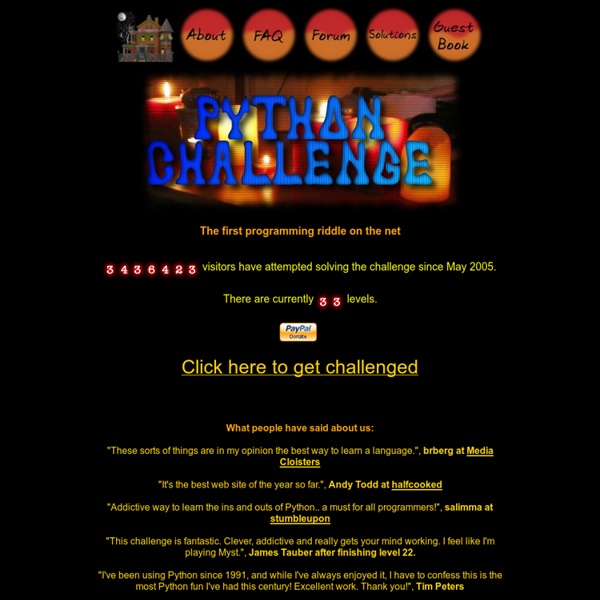



http://www.pythonchallenge.com/
Related: pythonSolving Every Sudoku Puzzle by Peter Norvig In this essay I tackle the problem of solving every Sudoku puzzle. It turns out to be quite easy (about one page of code for the main idea and two pages for embellishments) using two ideas: constraint propagation and search. Becoming a Pythonista — Platipy 0.2 documentation This chapter is will provide a very brief review of some important python concepts which will be useful and necessary. The basic concepts will be for those who are unfamiliar with Python, but a good refresher for those who don’t write in Python every day. Intermediate concepts will be great for programmers of all levels to refresh on some Python idioms.
Why Python — Pyzo - Python to the people Python is a very-high-level dynamic object-oriented programming language. It’s designed to be easy to program and easy to read. Guido van Rossum started the design of Python in 1980. Code Like a Pythonista: Idiomatic Python In this interactive tutorial, we'll cover many essential Python idioms and techniques in depth, adding immediately useful tools to your belt. There are 3 versions of this presentation: ©2006-2008, licensed under a Creative Commons Attribution/Share-Alike (BY-SA) license. My credentials: I am a resident of Montreal,father of two great kids, husband of one special woman,a full-time Python programmer,author of the Docutils project and reStructuredText,an editor of the Python Enhancement Proposals (or PEPs),an organizer of PyCon 2007, and chair of PyCon 2008,a member of the Python Software Foundation,a Director of the Foundation for the past year, and its Secretary.
Google for Education Welcome to Google's Python Class -- this is a free class for people with a little bit of programming experience who want to learn Python. The class includes written materials, lecture videos, and lots of code exercises to practice Python coding. These materials are used within Google to introduce Python to people who have just a little programming experience. The first exercises work on basic Python concepts like strings and lists, building up to the later exercises which are full programs dealing with text files, processes, and http connections.
Code Style If you ask Python programmers what they like most in Python, they will often say its high readability. Indeed, a high level of readability is at the heart of the design of the Python language, following the recognized fact that code is read much more often than it is written. One reason for Python code to be easily read and understood is its relatively complete set of Code Style guidelines and “Pythonic” idioms. Moreover, when a veteran Python developer (a Pythonista) points to portions of code and says they are not “Pythonic”, it usually means that these lines of code do not follow the common guidelines and fail to express the intent in what is considered the best (hear: most readable) way. On some border cases, no best way has been agreed upon on how to express an intent in Python code, but these cases are rare.
Python Examples On these pages, I have collected a bit of information about the Python programming language, along with a bunch of examples. These might be useful if you want to see some of the features without actually learning the language itself. You don't have to read through all of this in order. Just pick the pages which look most interesting to you. The topics are fairly independent from each other and don't require any existing knowledge about Python. Note: Some of the examples might require at least Python 2.3. doctest, unittest, and python 2.4's cool doctest.DocFileSuite Doctest and unittest are like 2 extremes of testing your python code. One is simple and intuitive and the other is powerful and requires more formality. In Python 2.4, doctest, builds in some of the power of unittest, perhaps bridging the gap between the two. This example shows you how to use doctest and the doctest.DocFileSuite feature. Python, 44 lines
The Python Tutorial Python is an easy to learn, powerful programming language. It has efficient high-level data structures and a simple but effective approach to object-oriented programming. Python’s elegant syntax and dynamic typing, together with its interpreted nature, make it an ideal language for scripting and rapid application development in many areas on most platforms. The Python interpreter and the extensive standard library are freely available in source or binary form for all major platforms from the Python Web site, and may be freely distributed.
The Python Tutorial Python is an easy to learn, powerful programming language. It has efficient high-level data structures and a simple but effective approach to object-oriented programming. Python’s elegant syntax and dynamic typing, together with its interpreted nature, make it an ideal language for scripting and rapid application development in many areas on most platforms. The Python interpreter and the extensive standard library are freely available in source or binary form for all major platforms from the Python Web site, and may be freely distributed. The same site also contains distributions of and pointers to many free third party Python modules, programs and tools, and additional documentation. The Python interpreter is easily extended with new functions and data types implemented in C or C++ (or other languages callable from C).